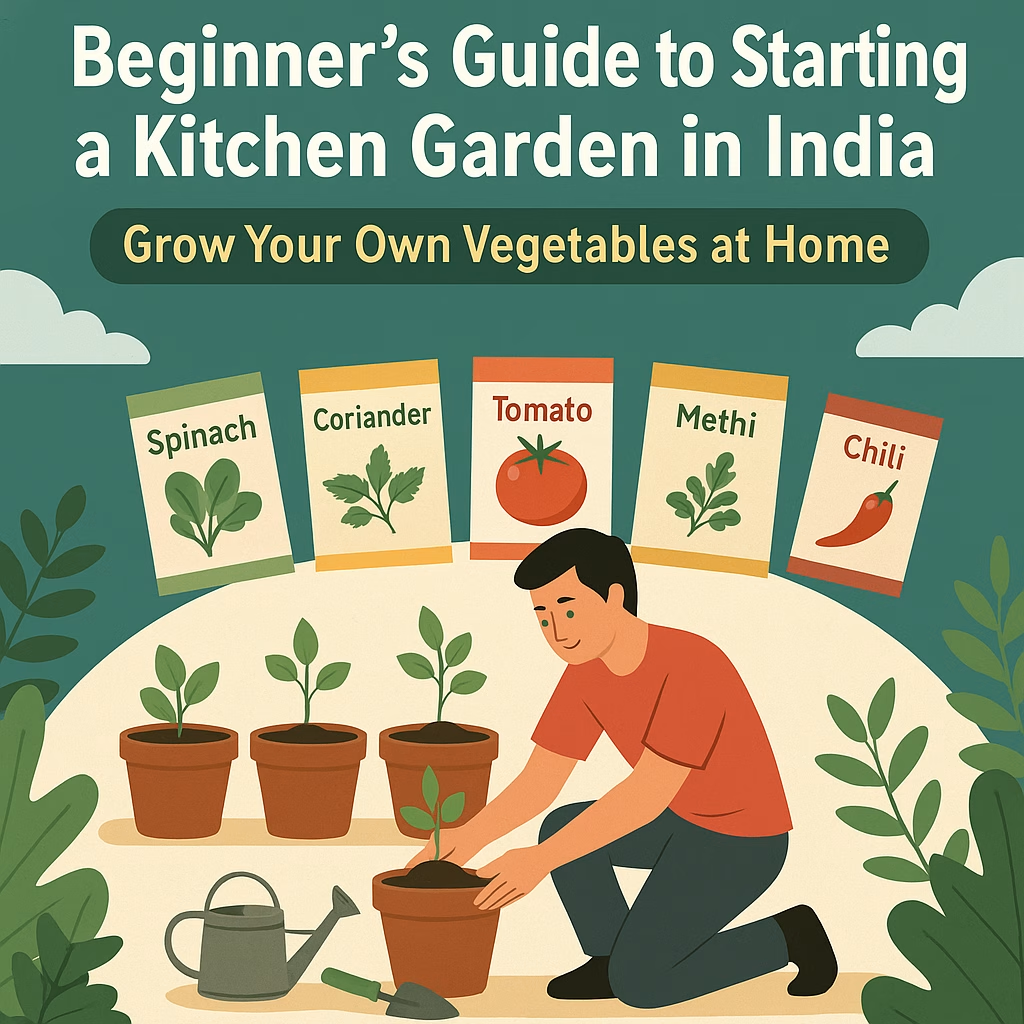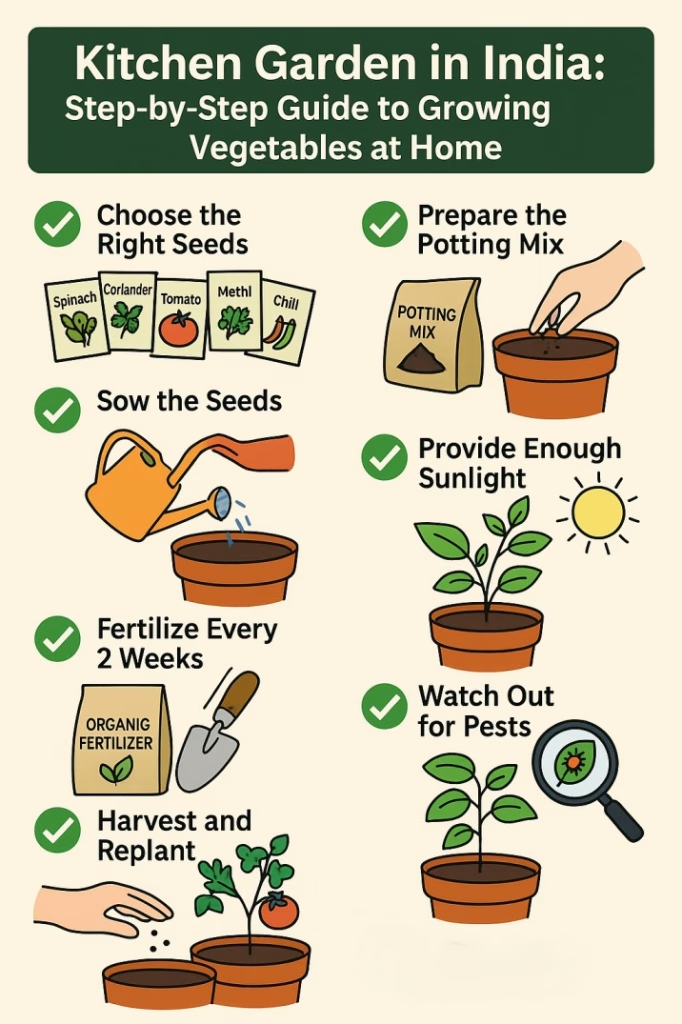Your cart is currently empty!

Kitchen Garden in India: Step-by-Step Guide to Growing Vegetables at Home
🌱 Why a Kitchen Garden in India is the Smartest Move You Can Make in 2025
Urban life is fast, noisy, and—let’s be honest—not always green. But what if you could create a peaceful, productive green corner right in your own home?
That’s where a kitchen garden in India comes in.
Whether you have a tiny balcony in Mumbai, a sunny terrace in Bengaluru, or a backyard in Punjab, you can grow fresh vegetables, herbs, and even fruits with the right knowledge and seeds. Kitchen Garden in India doesn’t require a lot of space or money—just some sunlight, patience, and the will to start.
At Sanjivani Bio Genetics India, we supply high-quality seeds, including our popular KGP (Kitchen Garden Packets) specially designed for Indian households. Let’s walk you through the entire process so you can start your garden today.
🌿 What is a Kitchen Garden in India?
A kitchen garden is a small, personal vegetable garden—usually grown near your kitchen, on a terrace, balcony, or backyard—where you cultivate edible plants like tomatoes, spinach, coriander, and more.
🔍 Why Are Kitchen Gardens in India So Popular?
There’s a growing trend toward organic home gardening in India, and here’s why:
-
🥗 Healthier food: No chemicals or pesticides
-
Saves money: Reduces trips to the vegetable market
-
🌼 Space-efficient: Great for small spaces and pots
-
🧘♀️ Mental wellness: Gardening reduces stress
-
🧒 Great for kids: Teaches sustainability and responsibility
🌞 Best Location to Start Your Kitchen Garden in India
When choosing a spot for your home garden, keep these factors in mind:
| Requirement | Ideal Condition |
|---|---|
| Sunlight | 4–6 hours of direct sun |
| Drainage | Pots or soil with good drainage |
| Protection | From harsh winds or heavy rain |
| Access | Easy to reach for watering and harvesting |
Here are a few location ideas:
-
Balcony: Ideal for pots and vertical gardening
-
Rooftop/terrace: Best for grow bags and trellised vegetables
-
Window sills: Great for herbs and leafy greens
-
Backyard/veranda: Best for larger beds or raised soil patches
Tip: South-facing balconies or terraces are the best because they receive the most sunlight in India.
🍅 What Can You Grow in a Kitchen Garden in India?
Many people think you need a farm to grow food. The truth? You can grow plenty of vegetables in just a few pots.
Here’s a quick list of what you can start with (and yes, all of these are available in KGP packets from Sanjivani):
-
Spinach (Palak)
-
Coriander (Dhaniya)
-
Fenugreek (Methi)
-
Tomato
-
Chili
-
Radish
-
Okra (Bhindi)
-
Carrot
-
Lettuce
-
Bottle gourd
Pro Tip: Always start with 3–4 varieties. This gives you a better chance of early success, builds confidence, and provides variety in your harvest.
🧂 Extra Ingredients for a Healthy Garden
Think of your kitchen garden like a recipe—seeds are the main ingredient, but other ingredients matter too:
-
🪴 Soil mix: Garden soil + compost + cocopeat
-
💧 Drainage: Use holes at the bottom of pots to prevent root rot
-
🍌 Fertilizer: Use homemade compost, banana peels, used tea leaves
-
🧴 Pest control: Neem oil spray, garlic-chili spray, marigold companion plants
🔄 Easy Gardening Schedule for Beginners
| Task | Frequency |
|---|---|
| Watering | Once daily (early morning) |
| Composting | Every 15–20 days |
| Pest check | Every 3–4 days |
| Harvesting | As per crop cycle |
| Replanting | After seasonal crops finish |
📈 Grow More in Less Space: Vertical and Container Gardening
Running short on space? Try vertical gardening. It’s a space-saving technique where you grow upward using:
-
Vertical planters
-
Wall-mounted shelves
-
Hanging pots
-
Trellis for climbers (like bottle gourd, beans, or cucumber)
You can also use:
-
Used buckets
-
Plastic bottles
-
Old paint containers
Just make sure there’s a drainage hole at the bottom of any container you use.
📷 Engage With Gardening: Take Photos, Track Growth
Gardening is more than just planting—it’s a journey. Here’s how to stay motivated:
-
Take weekly photos to track plant growth
-
Keep a gardening diary (physical or mobile app)
-
Share your progress on social media using tags like #MyKitchenGarden
This not only keeps you excited but helps inspire others to start their own green space.
🧘 The Wellness Bonus: Gardening Is Good for You
Many gardeners report improved mood, reduced anxiety, and better focus. That’s because:
-
You spend time outdoors and in natural light
-
You connect with the earth (literally!)
-
You eat fresher, healthier food
-
You feel proud of growing something on your own
It’s more than a hobby—it’s therapy with benefits you can eat!
🛒 What You Need to Get Started
✅ Basic Gardening Supplies:
-
Pots or grow bags (8 to 15 inches deep)
-
Potting soil (well-drained and rich in compost)
-
Watering can or spray bottle
-
Organic compost or cow dung
-
Gardening gloves and trowel
✅ Seeds to Begin With:
Start with fast-growing, low-maintenance vegetables. Here are the top picks from our KGP (Kitchen Garden Packets):
| Vegetable | Growing Time | Best Season | Container Size |
|---|---|---|---|
| Spinach | 30–40 days | Sep–Mar | Medium (8–10″) |
| Coriander | 3–4 weeks | All year | Shallow tray |
| Fenugreek | 3–4 weeks | Oct–Mar | Shallow pot |
| Tomato | 60–75 days | Oct–Jan | 12–15″ pot |
| Chili | 2–3 months | Feb–Apr | Medium pot |
🛒 Shop All Vegetable Seeds from Sanjivani Bio Genetics India
🌱 Step-by-Step Guide to Growing Vegetables at Home
✅ Step 1: Choose the Right Seeds
Select vegetables that match your local climate, season, and available space. For beginners, go with easy-to-grow crops like:
-
Spinach
-
Coriander
-
Tomato
-
Methi
-
Chili
Use trusted KGP seed packets from Sanjivani for higher germination and ease.
✅ Step 2: Prepare the Potting Mix
A healthy mix = healthy plants. Combine:
-
1 part garden soil
-
1 part compost (organic or vermicompost)
-
1 part cocopeat (for water retention)
Mix well and fill your pots or grow bags.
✅ Step 3: Sow the Seeds
-
Make small holes or rows in the soil (as per seed packet instructions).
-
Gently place seeds and cover with a thin layer of soil.
-
Keep spacing in mind to avoid overcrowding.
✅ Step 4: Water Gently
Use a watering can or spray bottle.
💧 Tip: Keep the soil moist—not soggy. Overwatering can rot the roots.
✅ Step 5: Provide Enough Sunlight
Ensure 4–6 hours of direct sunlight daily.
☀️ Ideal times: Early morning to noon.
Move pots around if needed to chase the sun!
✅ Step 6: Fertilize Every 2 Weeks
Use organic options like:
-
Kitchen compost
-
Cow dung
-
Vermicompost
Avoid chemical fertilizers for better taste and health.
✅ Step 7: Watch Out for Pests
Check leaves and stems regularly. If you notice damage:
-
Spray neem oil + water mixture
-
Use natural deterrents like garlic spray
-
Introduce friendly plants (like marigolds) to repel insects
✅ Step 8: Harvest and Replant
-
Harvest leafy greens early and often to encourage regrowth.
-
Pick fruits (like tomatoes or chilies) when they reach full color.
- After harvesting, remove old roots and prepare the soil for new crops.

💡 Pro Tip: Keep a small notebook or digital log to track which veggies grow best in your space and season.
📌 Common Mistakes to Avoid
❌ Overwatering – Can lead to fungal infections
❌ No sunlight – Stunted growth, yellowing leaves
❌ Poor soil – Low nutrient content reduces yield
❌ Ignoring spacing – Crowded roots compete for nutrients
💡 Pro Tips from Our Gardening Experts
🌿 Rotate crops every season to maintain soil health
🌿 Use used tea leaves, banana peels, and eggshells as natural fertilizers
🌿 Use mulch (dry leaves or straw) to retain moisture in pots
🛍️ Where to Buy Vegetable Seeds for Home Gardening?
You can’t grow healthy vegetables without quality seeds. That’s where Sanjivani Bio Genetics India comes in.
Why Choose Sanjivani Seeds?
-
✅ Germination tested for Indian conditions
-
✅ 10g Kitchen Garden Packets for urban growers
-
✅ Huge variety – from desi bhindi to hybrid tomatoes
-
✅ Affordable pricing with home delivery
-
✅ Serving farmers, home gardeners, and terrace growers alike
🛒 Browse All Vegetable Seeds Online
💬 Final Thoughts: Let’s Make India Greener, One Kitchen Garden at a Time
A kitchen garden is no longer a luxury—it’s a smart, sustainable choice. With just a few pots and the right seeds, you can turn any Indian home into a green, productive space.
At Sanjivani Bio Genetics India, we’re proud to support thousands of new gardeners with our high-quality, easy-to-use seed packets. If you’ve been thinking about growing your own food, there’s never been a better time to start.
So why wait? Plant today. Eat fresh tomorrow. 🌿


Leave a Reply